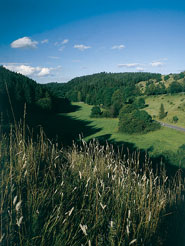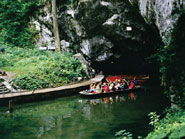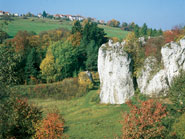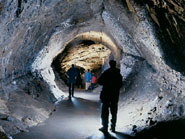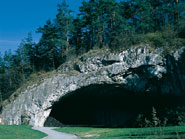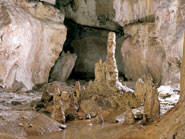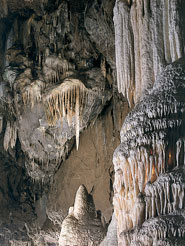NATURE RAMBLES THROUGH THE MORAVIAN KARST
Welcome to the Blansko region ...
... to the Moravian Karst, a region rich and hospitable, lying at the very
heart of South Moravia, beloved by the natives, admired by visitors, celebrated
by poets ...
The Blansko region and the Moravian Karst from a bird’s-eye
view
The Blansko region and the Moravian Karst lie between the Drahany Highlands and the Highlands of Bohemia and Moravia, to the north of Brno, the Moravia metropolis. The highest point of the Moravian Karst is Heliąova Skála (613 m), while another prominent peak is the hill known as Podvrąí (590 m) in Veselice, which boasts a modern look-out tower. If you surmount its 168 stairs it offers an enchanting view of the karst landscape.
Water sports and "water sprites"
Part of this region is the picturesque valley of the River Svitava
which is the destination of many water sports enthusiasts in the summer months.
The Moravian Karst is drained by the subterranean River Punkva. Jedovnice, and
the area around Oląovec Reservoir (see picture) in particular, is a centre for
recreation and water sports. The Palava recreation area, with its dam reservoir,
offers excellent facilities for relaxation in Blansko itself. You can also relax
by one of the many natural and artificial lakes in the region.
The secrets of the Forest Pantheon
You can also find an unusual natural park in the Blansko region, with a diverse collection of rare and exotic species of tree - the dendrological arboretum in Křtiny. This area of forest not only serves the needs of tree specialists, but also forms an attractive recreation area with an emphasis on the aesthetic effect. The site contains a number of commemorative plaques and memorials, devoted to leading foresters and artists celebrating nature.
To most of us the words "Moravian Karst" evoke unique stalagmite and
stalactite caves. In reality this is an extensive complex of unique natural
phenomena stretching over an area of 92 km2. The area can be divided into three
parts - the north, drained by the River Punkva; the middle section in the
catchment area of Křtiny Stream; and the south which belongs to the catchment
area of the Říčky Stream. Of the total number of 1,100 registered caves only
four are open to the public, all in the northern part of the Karst (the Punkva
Caves, Katherine Cave, Balcarka Cave and the Sloup-©oąůvka Caves). The other
caves remain hidden from the public and it is forbidden to enter them, both to
protect their rare stalagmite and stalactite formations from indisciplined
visitors and, first and foremost, for safety reasons. We recommend the more
adventurous and inquisitive of you visit some of the dry caves in the area, most
of which are well lit by daylight, which can be explored with no risk of danger,
for example Pekárna, Kostelík, Jáchymka, Kůlnička and Kolíbky in Rudice.
• The Punkva Caves
Part of the longest cave system in the Czech Republic - the "Amateur
Cave". During your visit you will find yourself at the very bottom of the
world-famous Macocha Abyss, 138.7 metres deep. On the way you will pass through
a system of enormous domes with magnificent stalagmite and stalactite
formations, culminating in Masaryk Dome, the most beautiful subterranean site in
the Moravian Karst. The tour comes to a climax with a romantic boat ride on the
subterranean River Punkva .
• Katherine Cave
Featuring the largest subterranean dome in the Czech Republic open to the
public (97 metres long, 44 metres wide and 20 metres high) and unique stalagmite
and stalactite formations comprised of a group of extraordinarily thin
stick-like stalagmites as much as four metres high, known as the Bamboo Forest.
Musical playback during the tour gives visitors the opportunity of admiring the
excellent acoustics of the Main Dome. Musical and choral concerts are held here
several times a year.
• Balcarka Cave
A two-storey cave maze of rambling corridors connected by chimneys and
high domes, with extremely rich polymorphous and colourful stalagmites and
stalactites . The natural entry portal is an important palaeontological and
archaeological site where numerous finds of the bones of Pleistocene animals,
flint and bone tools and fireplaces made by people from the Late Stone Age have
been made.
• The Sloup-©oąůvka Caves
An extensive complex of corridors and domes on two levels, connected by
enormous subterranean gorges as much as eighty metres deep. Concerts of chamber
music are held occasionally in the Eliąčina (Elizabeth) Cave, with its unique
stalagmite and stalactite formations. The caves are also used in the treatment
of diseases of the upper respiratory tract - speleotherapy. Part of the cave
system is the enormous Kůlna (Shed) Cave - one of the most famous and most
extensively investigated site of archaeological finds in the country .
Other remarkable features here include the typical karst canons known as
Pustý ®leb and Suchý ®leb (Desert Gully and Dry Gully), the Bílé Vody (White
Waters) Sink and, most notably, Amatérská Jeskyně (Amateur Cave), which is
however closed to the public. The chilling view into the depths of the Macocha
Abyss from Horní Můstek and Dolní Můstek (Upper and Lower Bridge) offers a truly
unsurpassable experience. The highlight of the middle section of the Moravian
Karst is the Rudice Sink, where the waters of Jedovnice Stream disappear
belowground, only returning to the surface at Býčí Skála (Bull Rock) in Josefov
after a twelve-kilometre journey through the mysterious underground. Bull Rock
is named after the famous bronze statue of a bull found there.
The extraordinarily rich and diverse range of karst phenomena is subject
to strict protection, as is the interesting flora and fauna in the area. This,
the largest and most developed karst area in the Czech Republic, was declared a
protected landscape reserve in 1956. The most valuable localities are also
protected within 14 nature reserves, where numerous unique examples of plants,
animals and natural formations are found. The rare flower Cortusa matthioli is
found only at the bottom of the Macocha Abyss. Bats, those typical cave
creatures, hibernate in the subterranean karst world.
The ecological transport system in the Moravian Karst respects the
interests of nature conservation. You will be taken from Skalní Mlýn (Rock Mill)
to the Punkva Caves and back again by train, while a ride in a cabin on the
cableway from Punkva Caves to the Upper Bridge on the Macocha Abyss offers an
unsurpassable experience.
| Cave | Open | Route length | Tour length |
| Punkevní | all-year-round | 1170 m | 60 min |
| Kateřinská | II. - X. | 430 m | 30 min |
| Balcarka | II. - X. | 600 m | 45 min |
| Sloupsko-ąoąůvské | II. - X. | 890 m (short route) | 60 min |
| II. - X. | 1670 m (long route) | 100 min |
Some practical advice in conclusion: in view of the enormous popularity of the caves in the Moravian Karst, they are generally fully booked many weeks in advance, particularly in the summer. We recommend you book your visit to the Moravian Karst (and the Punkva Caves in particular) at least two weeks in advance.
Reservations are handled by the Central Information Service in Skalní Mlýn:
Tel. 516 413 575, fax 516 415 379, email uismk@cavemk.cz

